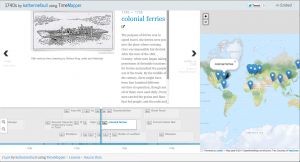Without chronology, history is just a million different little stories thrown together. According to Grafton, “While history dealt in stories, chronology dealt in facts.” (Grafton, 10) Chronology adds order and reliability to history. The chronology of events has shown Christians, for example, “when to celebrate Easter” or when other important events may occur (Grafton, 11). It is also useful for combining and comparing more than one “line” of events. For example, we can compare the history of a certain place in the world to another place and see which events happened at the same time and create an even broader history of events.
Modern timelines can show more than just the chronology of events. We can represent history not only via the chronology, but also via the importance and the geography of the events. Grafton observes that “Teachers and theorists claimed, over and over again, that chronology and geography were the two eyes of history: sources of precise, unquestionable information, which introduced order to the apparent chaos of events.” (Grafton, 17)

TimeMapper “clarified” historical events by adding a geographic aspect to each event. Along with ordering the events in chronological order, it also adds a pin onto the map for each event. Timeglider on the other hand, adds the importance aspect to each event. Along with ordering the events, you can adjust the size of the text of each event to signify the importance or relevance of each event depending on the subject of the timeline and ultimately the judgment of the creator.

Although each mode of representation offers a different “clarification” of the historical events, each one may also obscure parts of it. Sometimes it may look like two events occurred in the same location on the map in TimeMapper when in fact they occur in two different places just very close together. In Timeglider, events may be deemed unimportant when they should have been more important. These tools rely on the creator’s judgment and willingness to do deeper research before creating the timeline.
The point is, a line does not just represent the chronology of events. It is indeed a visualization of events over time. Therefore, it does not even just tell us a story; it shows us a story.
Leave a Reply